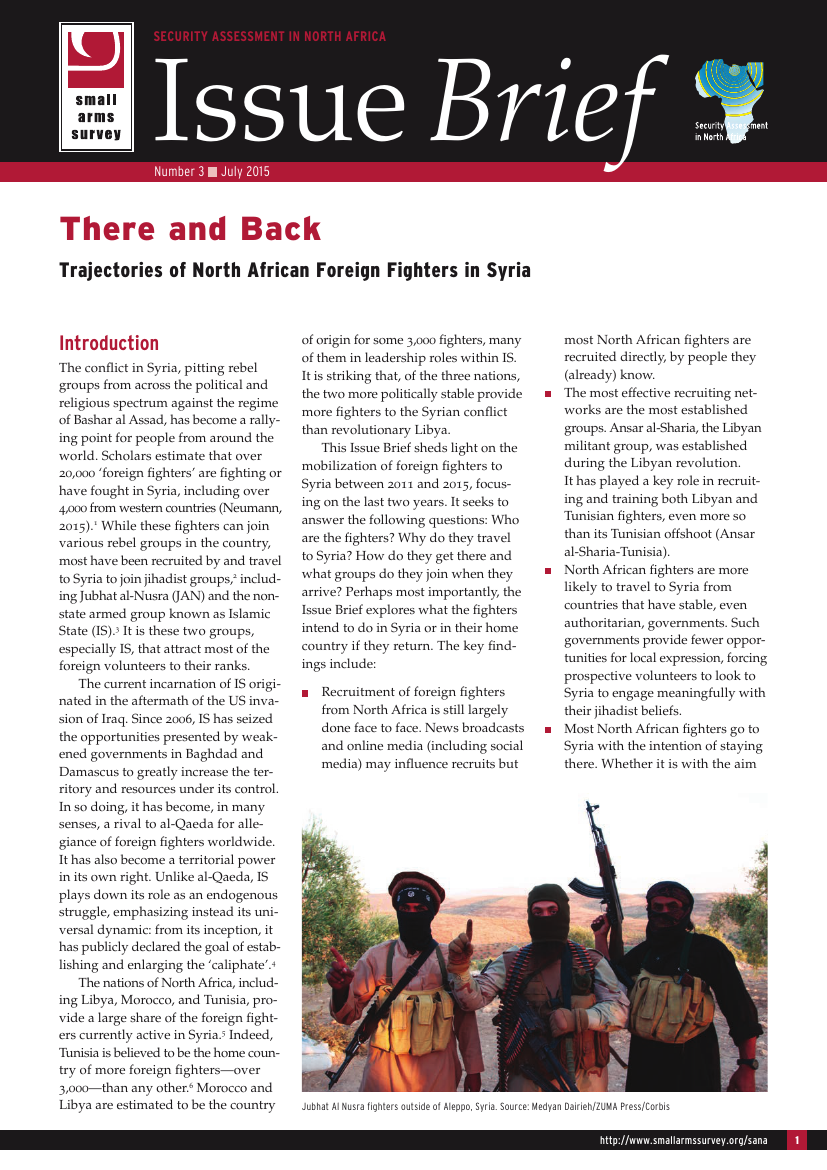
There and Back: Trajectories of North African Foreign Fighters in Syria (SANA Issue Brief 3)
The conflict in Syria has become a rallying point for jihadists from around the world. More than 20,000 foreign fighters are fighting or have fought in Syria, and most are part of jihadist groups, including Jubhat al Nusra (JAN) and Islamic State (IS). North Africa has provided a large portion of these foreign fighters, from countries as diverse as Morocco and Libya. Who are these North African fighters, and why are they going to Syria? What do they hope to accomplish there, and do they want to return to their home countries?
There and Back: Trajectories of North African Foreign Fighters in Syria, a new Issue Brief from the Small Arms Survey’s Security Assessment in North Africa (SANA) project, provides some answers to these questions.
The Issue Brief examines the motivations of North African fighters, including how they were recruited and how they made their way from their home countries to the Syrian battlefields. Using available literature and media reports, supplemented with interviews with experts, activists and Syrians who have lived under the yoke of IS, the Issue Brief also explores what North African fighters in Syria hope to gain by going there, and what they plan to do when they return home.
The Issue Brief’s primary findings include:
- Recruitment of foreign fighters from North Africa is still largely done face to face. News broadcasts and online media (including social media) may influence recruits but most North African fighters are recruited directly, by people they (already) know.
- The most effective recruiting networks are the most established groups. Ansar al-Sharia, the Libyan militant group, was established during the Libyan revolution. It has played a key role in recruiting and training both Libyan and Tunisian fighters, even more so than it’s Tunisian offshoot (Ansar al-Sharia-Tunisia).
- North African fighters are more likely to travel to Syria from countries that have stable, even authoritarian governments. Such governments provide fewer opportunities for local engagement, forcing prospective volunteers to look to Syria to engage meaningfully with their jihadist beliefs.
- Most North African fighters go to Syria with the intention of staying there. Whether it is with the aim of building the ‘new caliphate’ declared by the Islamic State, to escape difficult economic or social situations, at home or for other reasons, most fighters intend to either stay in Syria after the conflict ends or be martyred there.
- In Syria, reputation and experience count. Moroccans and Libyans have a reputation as effective fighters with tactical ability and experience. They often serve in senior positions within IS. Tunisians, in contrast, have less experience as fighters and are generally forced to prove themselves to their fellow jihadis, serving in more junior roles.
- When fighters return to their home countries, it is more likely to be because of disillusionment with the reality on the ground (Moroccans and Tunisians) in Syria or the deterioration of the situation in their home country (mostly Libyans) than it is to take up arms against their own governments.
Also available in ARABIC.
Have your say about Small Arms Survey publications and products: take 5 minutes to fill out our questionnaire.